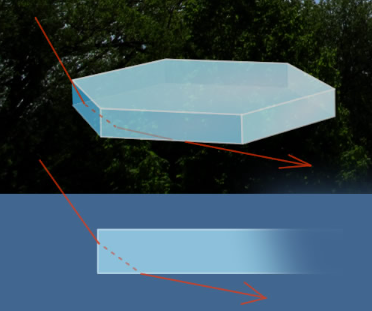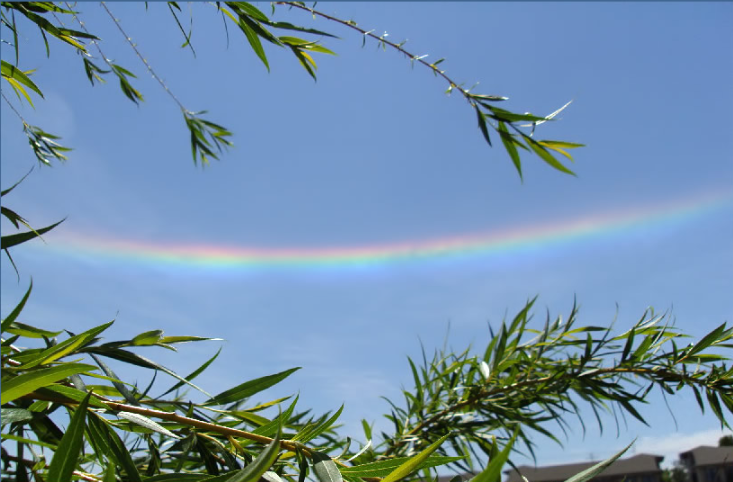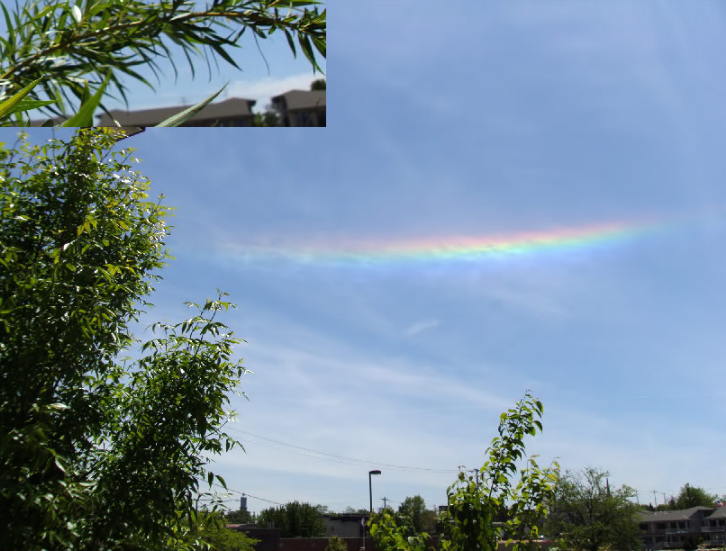OPOD - Wisconsin Circumhorizon Arc
OPOD - Wisconsin Circumhorizon Arc: A Spectacular Atmospheric Phenomenon
The Wisconsin Circumhorizon Arc is a breathtaking atmospheric optical phenomenon that graces the skies above Green Bay, Wisconsin. This stunning display of nature's beauty was witnessed by the seasoned observer, Peg Zenko of Tangent Photos, on May 27th, 2011. Peg, who has an eye for such marvels, typically spots around six circumhorizon arcs each summer. This particular event was not limited to a small area but extended over a wide region of Wisconsin, as evidenced by an image captured in Fort Atkinson.
The circumhorizon arc, also known as CHA, is an immense and vibrant ice halo that forms when sunlight passes through horizontally oriented plate crystals present in cirrus clouds. To catch a glimpse of this awe-inspiring phenomenon, one must look up when the sun is positioned high above 58°. In Peg's photograph, the sun is located outside the frame, while the upper halo visible is the familiar 22° halo or possibly a circumscribed halo. The CHA itself lies approximately twice as far below the sun.
Although the circumhorizon arc may seem rare due to its captivating appearance, it is actually quite common at latitudes below 45° where the sun shines for numerous hours each year and at the required altitude. Conversely, regions like Northern Europe are less fortunate in their opportunities to witness this spectacle, making it a rarity in those parts. The colorful nature of the CHA can be attributed to the refraction of light rays through ice facets inclined at 90°, which causes the separation of colors. Additionally, the parallel alignment of incoming sun rays minimizes color overlap, resulting in a vibrant display.
The circumhorizon arc is closely related to another dazzling atmospheric phenomenon known as the circumzenithal arc. This close relative shares the same colorful characteristics and is formed by sunlight refracted through ice crystals in cirrus clouds. While the circumhorizon arc is located at a considerable distance below the sun, the circumzenithal arc appears at a similar distance above it, creating a striking contrast in the sky.
The captivating nature of the Wisconsin Circumhorizon Arc was not limited to Green Bay alone. Chrys Wolnick, who happened to be over a hundred miles south in Fort Atkinson, WI, also witnessed a similar brilliant display at the same time. This suggests that the cloud conditions and horizontal plate crystals responsible for the formation of this phenomenon extended over a vast area on that particular day. Chrys' images, captured with permission, beautifully showcase the splendor of the CHA.
In conclusion, the Wisconsin Circumhorizon Arc is a mesmerizing atmospheric optical phenomenon that leaves observers in awe of nature's grandeur. Its appearance in the skies above Green Bay and Fort Atkinson, Wisconsin, serves as a reminder of the hidden wonders that can be found in our atmosphere. By understanding the science behind this phenomenon and appreciating its vibrant colors and unique characteristics, we can truly marvel at the remarkable beauty of our natural world.

Circumhorizon Arc
Peg Zenko (Tangent Photos) saw her first circumhorizon arc of 2011 on May 27th at Green Bay, Wisconsin. A seasoned observer, Peg sights on average six each summer. ©Peg Zenko, shown with permission.
The halo was seen over a wide area of Wisconsin - see a Fort Atkinson image below.

The circumhorizon arc (CHA) is a huge and colourful ice halo produced by sunlight refracted through horizontal plate crystals high in cirrus cloud.
Look for it when the sun is high (above 58°). Peg's picture at left is looking sunward and the sun is off the top of the frame. The upper halo is the familiar 22° halo (or maybe a circumscribed halo - it is hard to tell sometimes). The CHA is roughly twice as far below the sun.
The CHA is not uncommon at latitudes below 45° which have many hours per year with the sun shining and above the required altitude. Northern Europe is far less favoured and there the halo is hardly ever seen. Perhaps it is this that gives the halo its misleading reputation for being a rarity.
Why is it so colourful? The light rays forming it are refracted through ice facets inclined at 90° which widely separates the colours. Furthermore the incoming sun rays are parallel leading to very little colour overlap. An equally colourful halo is its close relation the circumzenithal arc.



Chrys Wolnick saw a similar bright circumhorizon arc at the same time. He was over a hundred miles to the south at Fort Atkinson, WI.
The same cloud conditions and horizontal plate crystals extended that day over a wide area.
Images ©Chrys Wolnick, shown with permission.

Note: this article has been automatically converted from the old site and may not appear as intended. You can find the original article here.
Reference Atmospheric Optics
If you use any of the definitions, information, or data presented on Atmospheric Optics, please copy the link or reference below to properly credit us as the reference source. Thank you!
-
<a href="https://atoptics.co.uk/blog/opod-wisconsin-circumhorizon-arc/">OPOD - Wisconsin Circumhorizon Arc</a>
-
"OPOD - Wisconsin Circumhorizon Arc". Atmospheric Optics. Accessed on November 26, 2024. https://atoptics.co.uk/blog/opod-wisconsin-circumhorizon-arc/.
-
"OPOD - Wisconsin Circumhorizon Arc". Atmospheric Optics, https://atoptics.co.uk/blog/opod-wisconsin-circumhorizon-arc/. Accessed 26 November, 2024
-
OPOD - Wisconsin Circumhorizon Arc. Atmospheric Optics. Retrieved from https://atoptics.co.uk/blog/opod-wisconsin-circumhorizon-arc/.